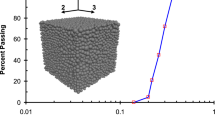Abstract
This paper deals with modeling of the interaction in overlapping cracks that the authors have earlier identified to be generic to a wide range of polymeric systems (Ramasamy and Lesser, J Polym Sci B Phys, 2003). A complex stress function method is used for evaluating stress intensity factors for interacting cracks. The interaction between two parallel overlapping cracks is considered first. It is shown for this case that the stress intensity factor can fall below the threshold value when there is sufficient overlap, leading to arrest of crack growth at the overlapping tip. Then the interaction in a doubly periodic infinite array of cracks is considered. The interaction in the array is found to be non-linear. However, at a given stress level, the highest density of stable cracks is related to the threshold value for crack propagation Kth though a simple set of equations. It is also shown that in an infinite array of cracks, the energy release rate criterion for crack growth is different from the stress intensity factor criterion due to a reduced stiffness of the material.
Similar content being viewed by others
References
Anderson TL (2004) Fracture mechanics; Fundamentals and applications. Int CRC, NY
Chudnovsky A, Kachanov M (1983) Interaction of a crack with a field of microcracks. J Eng Sci 21(8):1009–1018
Chen YZ (1984) General case of multiple crack problems in an infinite plate. Eng Fract Mech 20(4):591–597
Datsyshin A, Savruk MP (1973) A system of arbitrarily oriented cracks in elastic solids. J Appl Math Mech 37(2):326–332
Donald AM, Kramer EJ (1982) Internal structure of rubber particles and craze break-down in high-impact polystyrene (HIPS). J Mater Sci 17(8):2351–2358
Horrii H, Nemat-Nasser S (1985) Elastic fields of interacting in homogeneities. Int J Solids Struct 21:731–745
Kachanov M (1993) Elastic solids with many cracks and related problems. In: Hutchinson J, Wu T (eds) Advances in applied mechanics. Academic, New York, p 259
Karihaloo BL, Wang J, Grzybowski M (1996) Doubly periodic arrays of bridged cracks and short-fibre reinforced cementitious materials. J Mech Phys Solids 44(10):1565–1586
Ramaswamy S, Lesser AJ (2003) Genetic crack patterns in rubber-modified polymers under biaxial stress states. J Polym Sci Part B Phys 41(19): 2248–2256
Raman A, Farris RJ, Lesser AJ (2003) What is RSS? J Appl Polym Sci 88(2):550–564
Wilfong DL, Hiltner A, Baer E (1986) Advances in chemistry series. In: Paul DR, Sperling LH (eds) American Chemical Society
Wang GS, Feng XT (2001) The interaction of multiple rows of periodical cracks. Intl J Fracture 110(1):73–100
Author information
Authors and Affiliations
Corresponding author
Rights and permissions
About this article
Cite this article
Sankar, R., Lesser, A.J. Generic Overlapping Cracks in Polymers: Modeling of Interaction. Int J Fract 142, 277–287 (2006). https://doi.org/10.1007/s10704-006-9043-4
Received:
Accepted:
Published:
Issue Date:
DOI: https://doi.org/10.1007/s10704-006-9043-4




